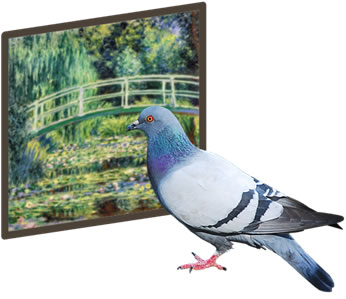2020-09-29

Visual categorisation is a useful way of organizing and simplifying incoming information from the envorinment around us. Over the past decade, birds have become a popular non-human animal model for vision due to their highly evolved visual systems and abilities. In this study we recorded neural activity from three pallial brain areas in pigeons: the nidopallium caudolaterale (NCL), an analogue of mammalian prefrontal cortex; the entopallium (ENTO), an intermediary visual area similar to primate extrastriate cortex; and the mesopallium ventrolaterale (MVL), a higher-order visual area similar to primate higher-order extrastriate cortex, while the birds performed an S+/S− Picasso versus Monet discrimination task. In NCL, we found that activity reflected reward-driven categorisation, with a strong left-hemisphere dominance. In ENTO, we found that activity reflected stimulus-driven categorisation, also with a strong left-hemisphere dominance. Finally, in MVL, we found that activity reflected stimulus-driven categorisation, but no hemispheric differences were apparent. We argue that while NCL and ENTO primarily use reward and stimulus information, respectively, to discriminate Picasso and Monet paintings, both areas are also capable of integrating the other type of information during categorisation. We also argue that MVL functions similarly to ENTO in that it uses stimulus information to discriminate paintings, although not in an identical way. The current study adds some preliminary evidence to previous literature which emphasises visual lateralisation during discrimination learning in pigeons.

Visual categorisation is a useful way of organizing and simplifying incoming information from the envorinment around us. Over the past decade, birds have become a popular non-human animal model for vision due to their highly evolved visual systems and abilities. In this study we recorded neural activity from three pallial brain areas in pigeons: the nidopallium caudolaterale (NCL), an analogue of mammalian prefrontal cortex; the entopallium (ENTO), an intermediary visual area similar to primate extrastriate cortex; and the mesopallium ventrolaterale (MVL), a higher-order visual area similar to primate higher-order extrastriate cortex, while the birds performed an S+/S− Picasso versus Monet discrimination task. In NCL, we found that activity reflected reward-driven categorisation, with a strong left-hemisphere dominance. In ENTO, we found that activity reflected stimulus-driven categorisation, also with a strong left-hemisphere dominance. Finally, in MVL, we found that activity reflected stimulus-driven categorisation, but no hemispheric differences were apparent. We argue that while NCL and ENTO primarily use reward and stimulus information, respectively, to discriminate Picasso and Monet paintings, both areas are also capable of integrating the other type of information during categorisation. We also argue that MVL functions similarly to ENTO in that it uses stimulus information to discriminate paintings, although not in an identical way. The current study adds some preliminary evidence to previous literature which emphasises visual lateralisation during discrimination learning in pigeons.